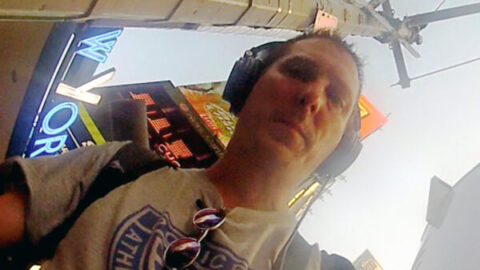Composer Kevin James will be presenting a Cage related project (modelled on Cage’s own 49 Waltzes for the Five Boroughs), 100 Waltzes for John Cage at the DiMenna Center for Classical Music from August 21, to the 23rd. He kindly took some time to answer 5 questions about it…
What is 100 Waltzes for John Cage?
100 Waltzes for John Cage is an homage written on the centennial of this iconic figure, and it is a tenderly rendered postcard to him from the city he loved so much. More specifically 100 Waltzes for John Cage is a randomly-evolving soundscape made up of 9 transient iPad-equipped musicians, 100 waltzes, quad speakers & audio from 147 New York City locations in a sublime expression of “the 10,000 things”.
OK, so let’s break that down a little. Cage actually didn’t like the word “random”. He preferred “indeterminacy” and “chance operations”. But we’ve got these nine musicians with ipads (that’s three trios worth). And on their ipads are slides with fragments of music from 100 different waltzes. (The fragments were chosen using chance operations of the i-ching – it involves zillions of coin tosses. We did it using a computer). So before the slides were made, the i-ching determined the page number, bar number, staff number, and number of bars to be included. Here’s where we get to the “random” part – the slide show on the ipad is controlled by a randomizing algorithm (I swear I didn’t make that word up) which determines how long that particular slide remains visible to the individual musician and the order that the slides appear.

Is this a soundscape?
The work is a soundscape in that I visited 147 locations throughout New York City, which also were chosen through chance operations using the i-ching (Cage loved using the i-ching), and I created 3 minute field recordings in each location. I did this in three sessions over the course of a week. The first session lasted 24 hours, midnight to midnight, while I drove quite literally to the far corners of NYC. The second session lasted 10 hours working south from the Bronx and down into Manhattan. For the third session I rode my bike for 10 hours, starting near my home, in Inwood Hill park, down through Central Park to the East side and onto Governors island then working my way North and finishing in Times Square.
These samples become a soundscape when loaded onto a computer and fed through a randomizing algorithm (there’s that term again) which determines how long each sample is heard, when it begins, and which of the four speakers at each corner of the room the sound will emanate from.
By the way, the ten thousand things is a buddhist term meant to represent “all of reality” or “the infinite”, which Cage was very into. It is conceptually possible that a playing of this piece could, by chance, involve the sounding of 10,000 notes by the musicians.
How did you pick the 100 waltzes? Did you write any?
The 100 waltzes were drawn from several lists of “the world’s 100 favorite waltzes”. None are original. All are from the public domain, and most have tunes that are quite familiar.
![The [kāj] ensemble The [kāj] ensemble](https://icareifyoulisten.com/wp-content/uploads/sites/3/2012/08/KajCompositePromo.jpg)
What would you hope to inspire through this piece?
My model for this piece was Cage’s own 49 Waltzes for the Five Boroughs, for which he recommended the playing of familiar waltzes if it was to be realized musically (which, as far as I’m aware, it has not been).
But to be honest, inspiration is a funny thing. I’m not sure that Cage chose to create out of a sense of inspiration, or the desire to inspire, as much as a desire to connect. He chose to connect by listening and by creating works that offered his audiences the same opportunity. One of Cage’s more famous moment’s of clarity involved the realization that the street sounds entering the window of his studio were far more interesting than anything he was trying to put on paper that day. I think later his thinking would evolve to the understanding that the sounds themselves, timbre, rhythm, diversity, contrapuntal interactions and whatnot, despite their inherent fascinating qualities, required his window to be open and his mind to be willing in order for any connection, clarity, understanding, joy, to take place. 100 Waltzes for John Cage celebrates that window and invites its audience to experience that connection.
Cage’s (and others’) experiments in indeterminacy seem to inspire so many young musicians today. Could it be a reaction to the increased amount of control (over our lives, over time, space, matter, etc.) that technology gives us?
I think that, at least in part, it’s due to the ubiquity of technology. Ravi Shankar gave his first public recital when he was 35. His daughter gave hers as a teenager. When asked about why this was, Mr. Shankar responded simply – “CDs”. She was able to study the playing of a multitude of masters almost without limitation through technology, while he was only able to listen to the playing of a single master for a limited amount of time each day.
So wait, what does Ravi Shankar have to do with Cage and indeterminacy? Musicians are able to be far more prepared now than even the recent past. They are both well versed and open to a greater diversity of music, styles, ideas. So they are also more easily bored. They desire experiences that will both challenge them and connect them to one another in new ways.
100 Waltzes for John Cage
Kevin James/The [kāj] ensemble
at The DiMenna Center Mary Flagler Cary Hall (lower level)
From August 21 through 23, 7:30 PM
Tickets are available on BrownPaperTickets: General $20, Students, Seniors $10
























